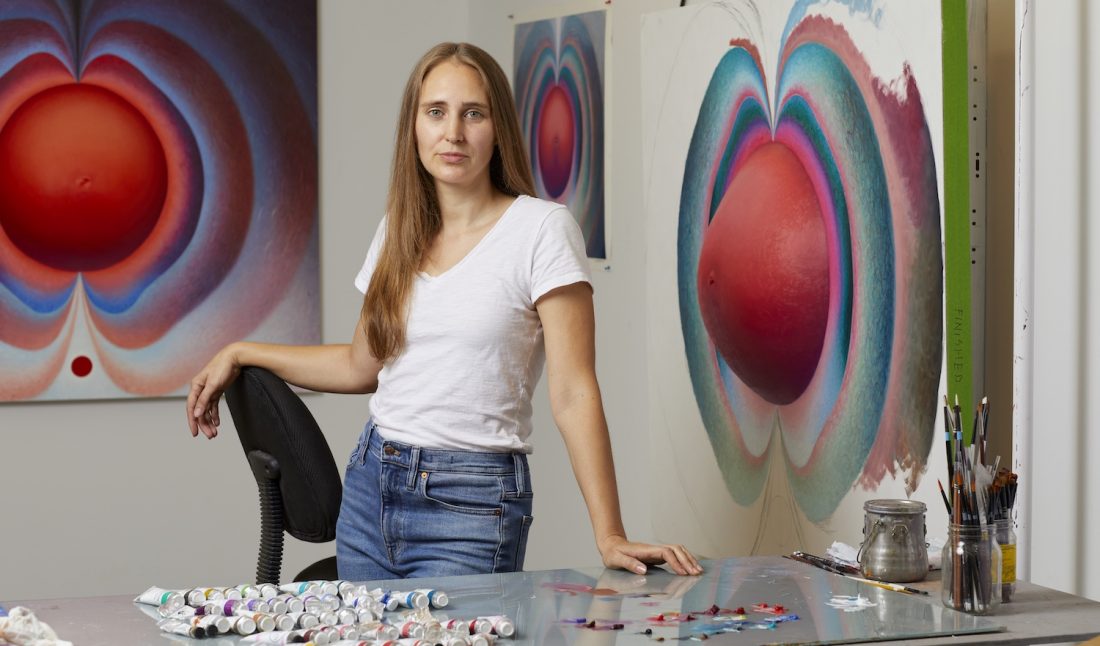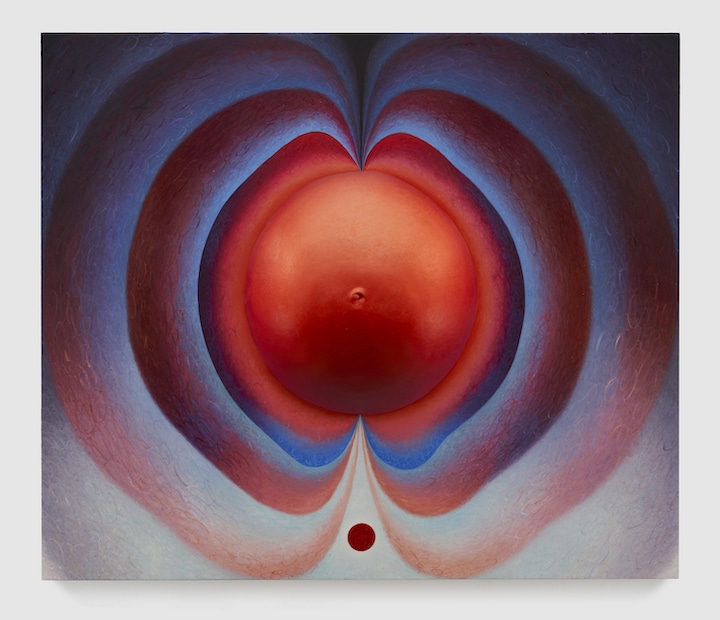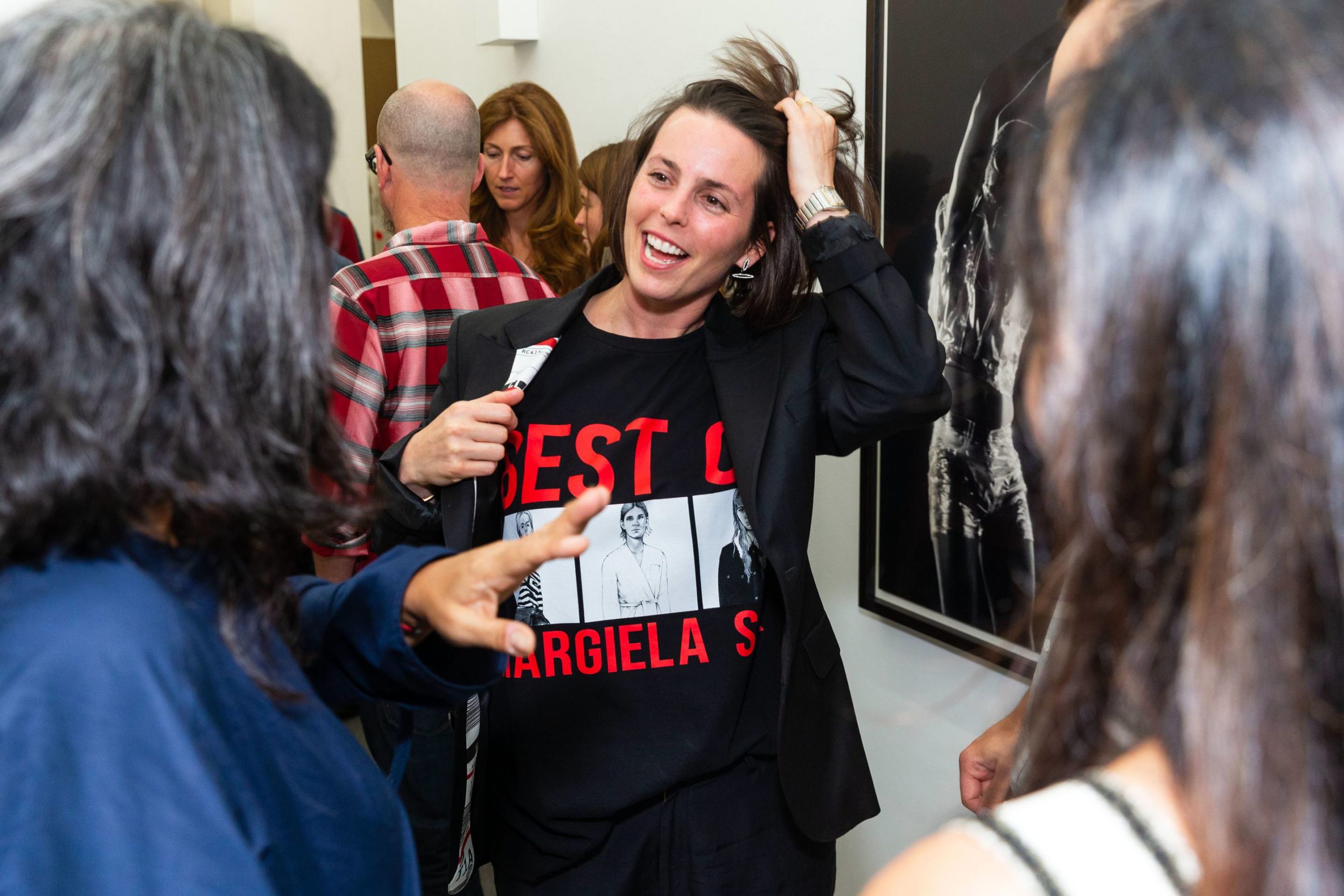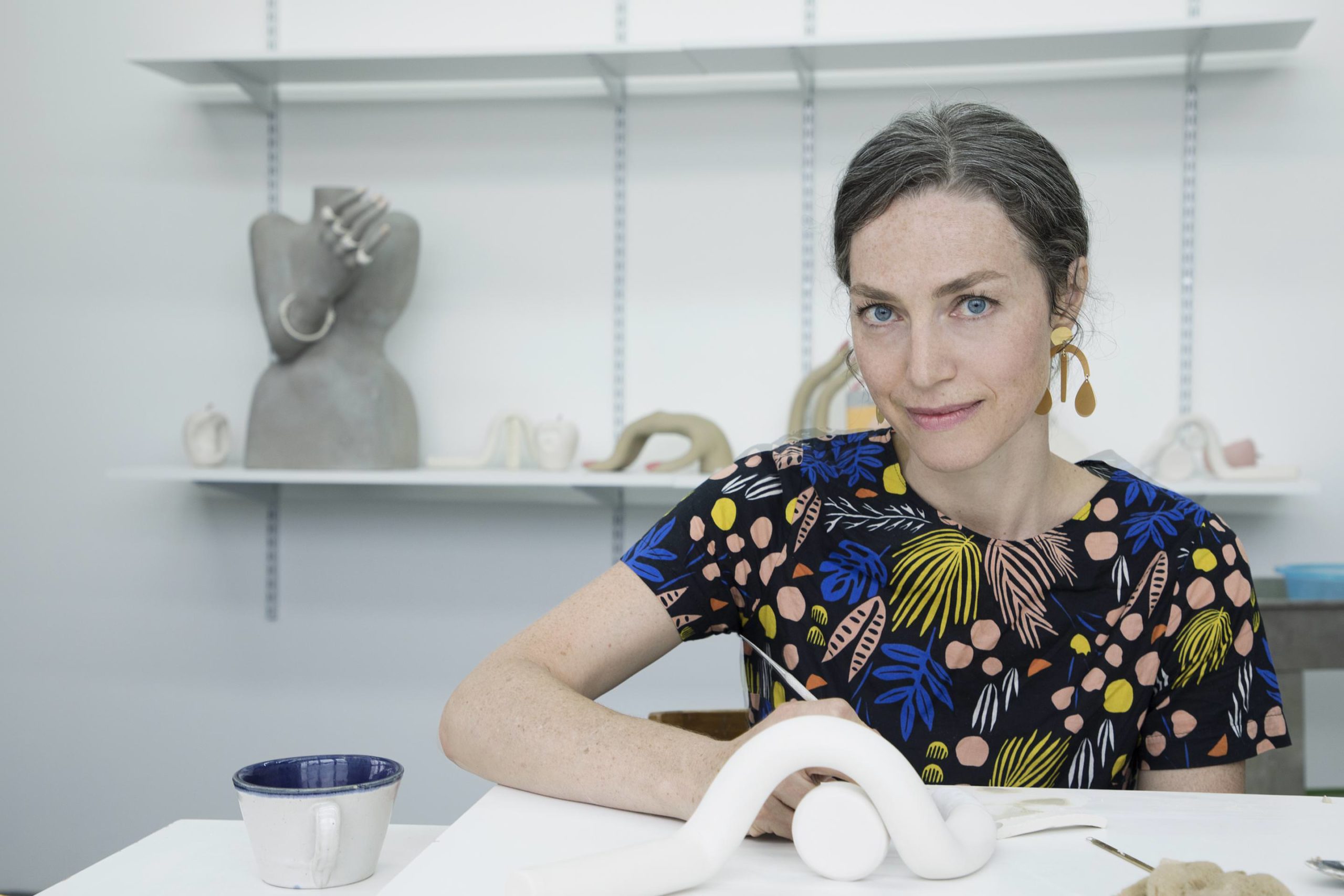Loie Hollowell’s paintings make you want to get up close. Her incredible use of color to render shapes and light stops you in your tracks. And her unique way of working the surface of the canvas draws you further in. It’s there you’ll see these paintings are actually 3D, where spheres and half spheres reveal their weight, their heaviness. There are shapes Hollowell turns to in order to evoke parts of the body—the breast, the belly, the vulva, the thighs. Or the artist works from her own body to go beyond evocation and actually casts the nipple or the protruding belly button. We see the lumps and bumps of skin, the corporeal imperfections, the swirls of hair, the drips of breast milk. While they are rooted in the very personal experiences of bodily transformation—life, loss, growth, joy, and pain—they are also transcendent, tapping into something universal and even otherworldly.
Loie Hollowell on view at The Aldrich Museum This Summer
The past decade of Hollowell’s practice is currently on view at The Aldrich Contemporary Art Museum through August 11, 2024. Entitled “Loie Hollowell: Space Between, A Survey of Ten Years,” it is her first museum survey, taking place in Ridgefield, Connecticut. At the time of its opening in January, on the opposite coast was her recent solo show at Jessica Silverman Gallery, “In Transition,” featuring a suite of 10 paintings that marked each stage of dilation in labor (from 1 centimeter to 10 centimeters). There, her cast bellies radiated with light and color, transitioning from warm yellows to deep blues and purples. At The Aldrich, several works on view have not been seen before, pulled from the artist’s own archives. They are joined by drawings, a significant part of the artist’s practice, and showcase her incredible ability to tap into abstraction, figuration, surrealism, and Light and Space in order to engage her viewers with issues of body autonomy, motherhood, care, and community.
“My instinct is always to do something different, try something different,”
-Loie Hollowell
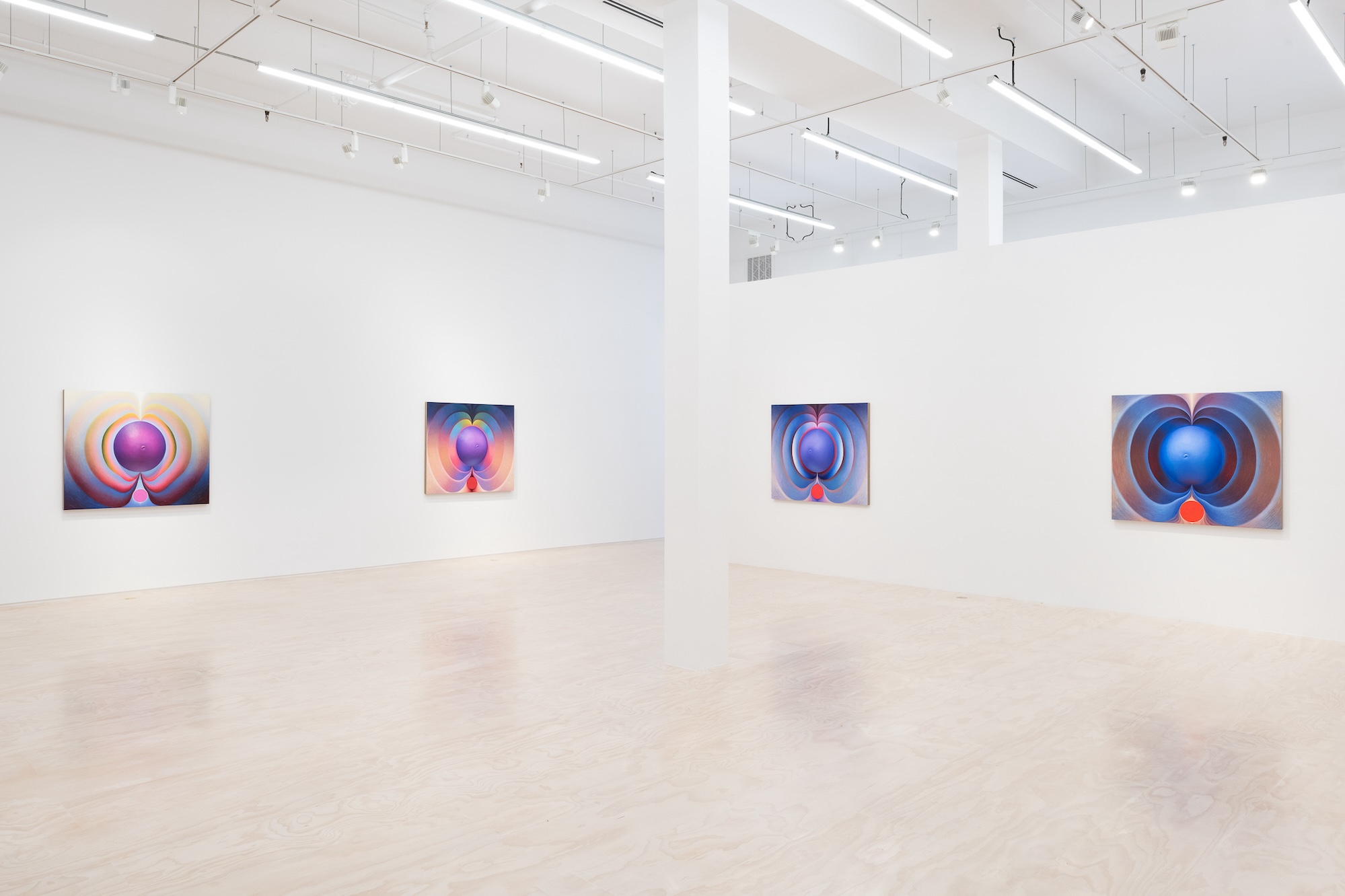 Installation view of Loie Hollowell, “In Transition,” 2024, at Jessica Silverman, San Francisco, photo by Phillip Maisel,
courtesy of the artist and Jessica Silverman, San Francisco.
Installation view of Loie Hollowell, “In Transition,” 2024, at Jessica Silverman, San Francisco, photo by Phillip Maisel,
courtesy of the artist and Jessica Silverman, San Francisco.
WHITEWALL: For your survey at The Aldrich, what was it like to look back at ten years of work?
LOIE HOLLOWELL: Amy Smith-Stewart came by the studio at one point, and I had a whole flat file of works that I’d hung on to. I thought they were really pivotal works that marked a transition that I didn’t want to let go of. A lot of them were works I didn’t think were good and I never made them into paintings. The space of drawing is much more playful and open-ended and less resolved for me. So there’s a lot of drawings that in my flat file they just sit there.
I showed them to Amy, and she was like, “We can show these! They are very interesting.” She was pointing to pieces that I thought were hideous and saying, “This would be really good to have in the show.” So I ended up framing all the works in this drawing room, and I’m going to keep them in my collection.
The earliest ones were from 2013. Through going back in time with Amy and pulling these out and realizing how far back they went, I was reignited with the memory of what had transpired at this time, which was this abortion I had in 2013. I totally forgot that that was this pivotal point of transition.
I remember going to the Women’s March in 2017 and standing up on the bus—everyone got a bus together—I stood up and I said, “My abortion changed the trajectory of my practice. I wouldn’t be who I am today without being able to have that abortion.” I was remembering how I was so aware of that being this pivotal point in my life. And also remembering when I first started talking about it with different galleries, they were like, “Maybe you don’t need to share this element of this part of your practice because this is a very sensitive issue.”
So it was really through the conversation with Amy that I realized that could actually be something I bring up and make as part of work because those early drawings, those two graphite drawings that were made right after my abortion, they were specifically about them. It also made me realize how influenced I was by Judy Chicago at the time. Using her as a template and then realizing I had been looking at Charles E. Burchfield a lot, and Arthur Dove, and Kay Sage, all these different periods of American modernists that were super influential.
WW: That must be interesting to go back and look at that version of yourself.
LH: I know, and it’s just funny because it’s not that long ago. But how quickly even within this short period of time—having kids, too—so much changes so quickly.
The work in the last room at The Aldrich is of paintings I just held on to, because they didn’t sell or I didn’t feel comfortable selling them. One of them I made and I realized it was a one-off. It’s this big pastel I’d made with these big circle nipples transitioning from blue to orange and it was so hard to make I realized I had to keep it.
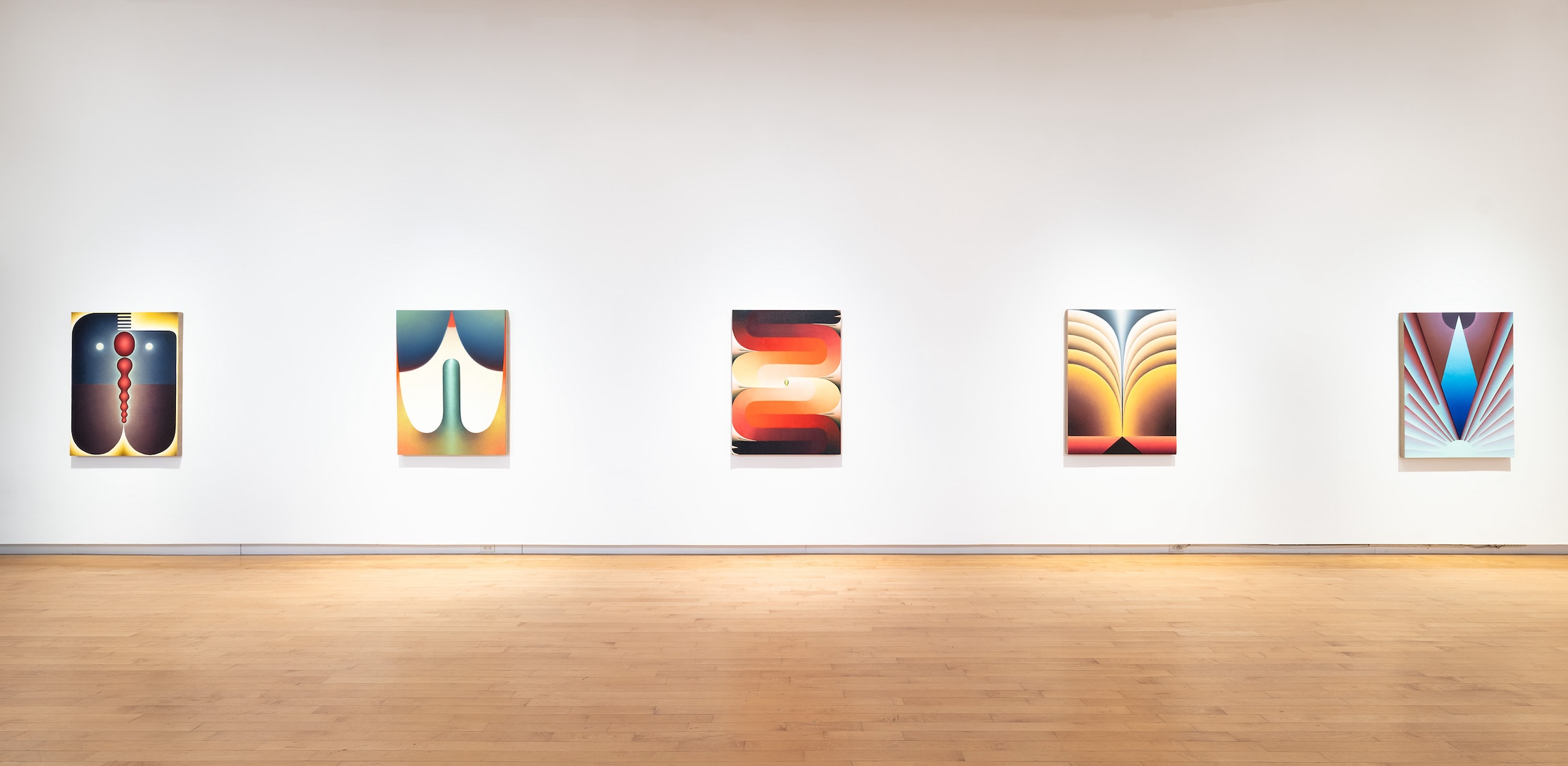 Installation view of “Loie Hollowell: Space Between, A Survey of Ten Years,” at The Aldrich Contemporary Art Museum (January 21—August 11, 2024), photo by Jason Mandella, courtesy of the artist.
Installation view of “Loie Hollowell: Space Between, A Survey of Ten Years,” at The Aldrich Contemporary Art Museum (January 21—August 11, 2024), photo by Jason Mandella, courtesy of the artist.
WW: Was revisiting these things inspirational for what you want to do in the studio now or try next?
LH: That’s a good question. I feel it’s definitely been a little stressful to see all of the work. One of my concerns as an artist is that I feel like I’m someone who gets bored very quickly and I’ll want to move to something else. I’ve been more hesitant to transition really quickly. I’ve kind of kept focusing on things, which I think is really good, I think it’s good to keep readdressing, focusing on the same idea, and really creating a strong language for yourself. But my instinct is always to do something different, try something different, and the pregnancy and doing the body cast work were kind of the transitioning point of doing that. I think when I see all these works together, in my mind they all look very different. I hope that in the context of a hopefully longer career, there will be a number of other changes that can kind of contextualize why I’ve done what I’ve done. Because I don’t know exactly why. I know that I’ve had to change, but I can’t justify it per se. Because I’m still in the process of it.
WW: You can’t have a bird’s-eye view yet because you’re in it.
LH: Yeah. There is a lot of visual energy that in the earlier paintings in the first room that I really love that I think I gave up when I wanted to bring in the body casts that I want to bring back in. So I’m invested right now in figuring out how to keep that abstraction and the color and the sense of light and transcendental light elements in the work. Because, actually, that kind of formal investigation is super engaging. I’m figuring out how to get back into that right now. And maybe the nipple paintings are helping me get there.
WW: How so?
LH: I’m really wanting to get back into that sense of light and chiaroscuro and contrast and color as the character of the work and not have it be overpowered by a pregnant or a sexual form. But still having that in the dialogue but not at the forefront.
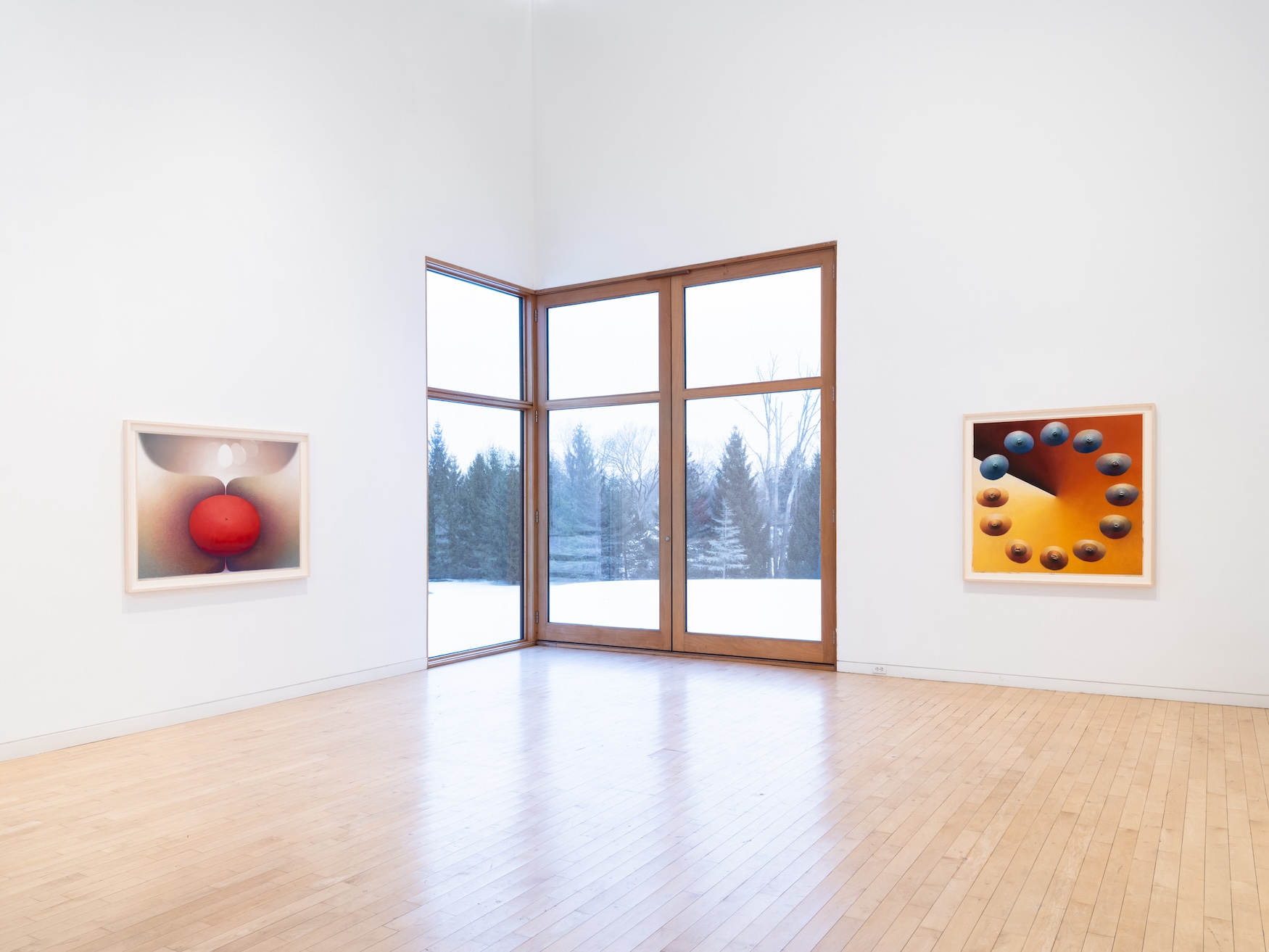 Installation view of “Loie Hollowell: Space Between, A Survey of Ten Years,” at The Aldrich Contemporary Art Museum (January 21—August 11, 2024), photo by Jason Mandella, courtesy of the artist.
Installation view of “Loie Hollowell: Space Between, A Survey of Ten Years,” at The Aldrich Contemporary Art Museum (January 21—August 11, 2024), photo by Jason Mandella, courtesy of the artist.
“I liked the idea, too, of really impregnating this masculine rectangle,”
—Loie Hollowell
WW: Do you take in people’s reaction to your work? Myself included, I find people so respond to your paintings. They feel them in their own bodies.
LH: Yes! The energy that I’ll get in the presence of someone looking at the work is what I need. When people come to me or they are at the show when I’m there, that’s the energy that I need.
At the opening of the Jessica Silverman show, we had it early so that my kids could come, and a mom came with her five-year-old. They ran around to each piece, a mom trying to get in an art show with her kid before putting him to bed. He was pointing things out, and she was very engaged with him and they went in so efficiently that I didn’t get a chance to stop them and say hey. I found her afterward and reached out, and that’s the kind of engagement that is very endearing.
People reach out, too, on Instagram. They say, “I found this work while I was pumping,” or “I found this painting online while I was breastfeeding and totally relate.” Those beautiful moments are equally pushed away by some very few negative ones. It’s such sensitive work that I have to be conscious of what I’m letting in.
WW: One of the newer works on view at The Aldrich is 11pm, 1am, 3am, 5am, 7am, 9am (2023). Can you tell me about that piece?
LH: With these nipple paintings, it’s a series of six and they are titled the hours of the feeding time. That series is what I’m most excited about right now. The nipple itself is such a minor character in the painting, but it’s actually the source of the light. It’s very minimal. You don’t see it upon first approach to the painting. You’ll see that there’s a little nub on it, but you don’t know what it is. The light comes out from that source in a reference to the let down, the drip of milk that comes down with breast feeding before you start feeding. For me, that’s been the most successful engagements of the body and light, these nipple paintings.
Loie Hollowell’s Paintings are of the Body and the Universe
WW: The way you’re able to make light radiate can feel so transcendental—like in your “In Transition” series.
LH: I was thinking about the magnetic fields of the earth. If you look up magnetic fields of earth, you get a beautiful diagram of the North and South poles. Once I abstracted the belly to such a circular shape, I was thinking about how earthly it became, or planetary. I was thinking of that, but also just like the radiating energy that comes with each of the contractions, and trying to think about how energy and pain can be imaged in color and the concentration of color that disseminates out as the pain lessens.
With the nipple paintings and the belly paintings, I liked the idea, too, of really impregnating this masculine rectangle. The body parts really took over the whole space that they almost felt more like sculptures, like figurative realistic sculptures. Whereas these to me feel like it’s still a painting space that’s then been impregnated with this female reproductive body part.
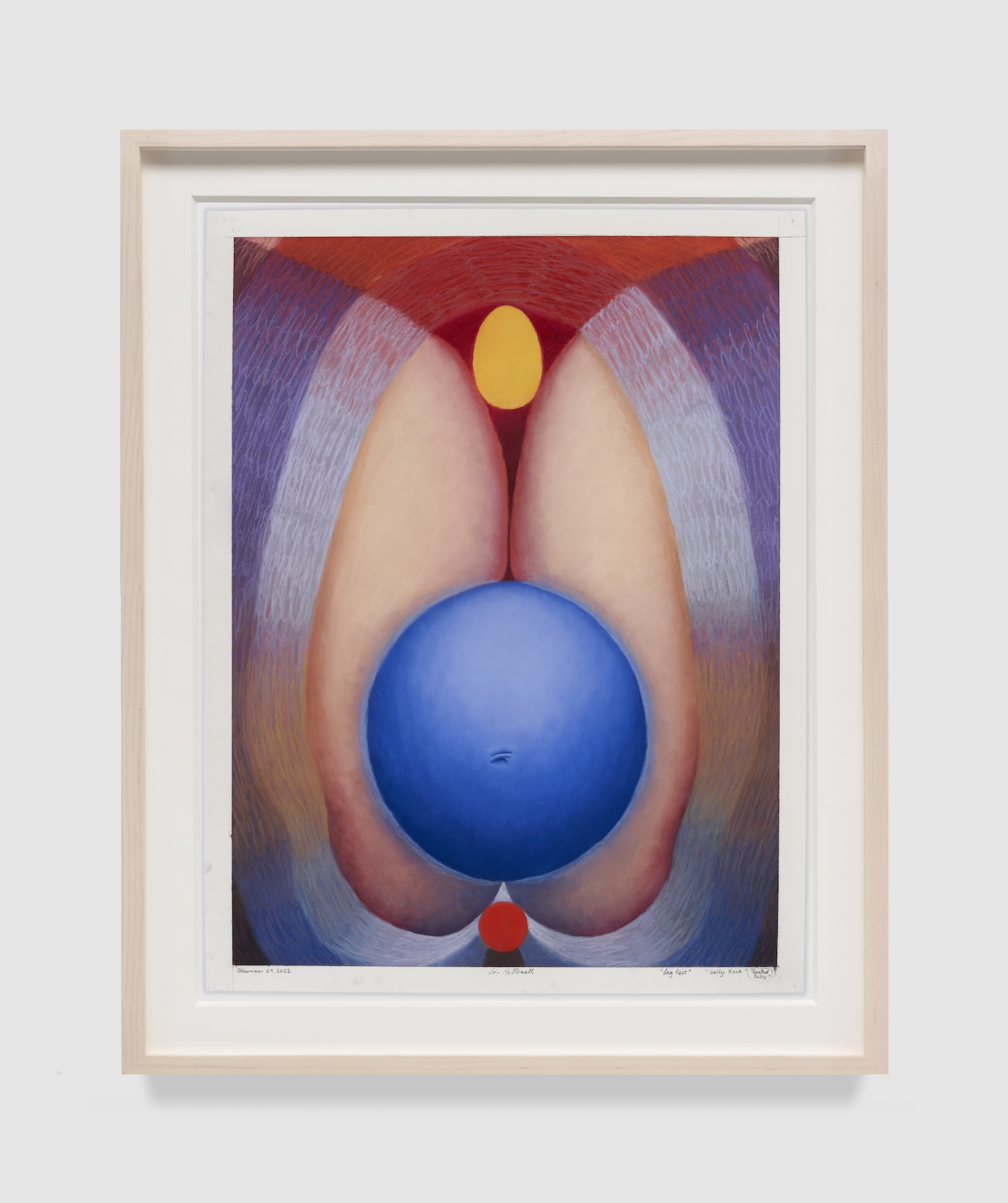 Loie Hollowell, Seated Belly, December 29, 2022, soft pastel on paper, 30 x 23 inches, photo by Melissa Goodwin,
courtesy of the artist and Pace Gallery.
Loie Hollowell, Seated Belly, December 29, 2022, soft pastel on paper, 30 x 23 inches, photo by Melissa Goodwin,
courtesy of the artist and Pace Gallery.
WW: How long have you been in your current studio?
LH: This studio is brand new. My husband and I bought the building a few years ago, and we spent a year gut renovating it. Now it’s this very wonderful studio with great light. It’s our forever space. It’s big enough that we can grow into it together. He has his studio on one site, I have mine on the other. And there is a sculpture area in between where we build up the surfaces.
WW: I was reading about how your dad set up a studio for you when you were a young kid. Having kids of your own, are they often in the space?
LH: Yeah, my son has come here after school with our nanny. He’ll come and make some art here with her. There’s a work area in the middle of the space. The space is big enough that we have fantasized about having our friends’ kids come over and do stuff after school, but we haven’t figured that out yet.
What was really special about my growing up is that my dad’s studio was on the property. We had almost an acre out in the middle of nowhere surrounded by fields. There was nowhere else I could go, so I would go to my dad’s studio and watch him paint.
I’m hoping as they get older, they’ll want to take over an element of the space here, like I did, but I don’t know how New York City kids grow up. It’s such a different world. They could get interested in anything.






